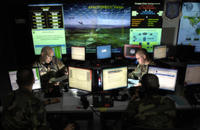-
"Stutter jump" could improve performance of search and rescue robots
A new study shows that jumping can be much more complicated than it might seem; in research that could extend the range of future rescue and exploration robots, scientists have found that hopping robots could dramatically reduce the amount of energy they use by adopting a unique two-part “stutter jump”
-
-
Smart camera to describe what it sees -- and reason about what it cannot see
Army scouts are commonly tasked with covertly entering uncontrolled areas, setting up a temporary observation post, and then performing persistent surveillance for twenty-four hours or longer; what if instead of sending scouts on high-risk missions the military could deploy taskable smart cameras? A truly “smart” camera would be able to describe with words everything it sees and reason about what it cannot see
-
-
Approaches to international consequence management for CBRNE incidents
The National Research Council (NRC) of the National Academy of Sciences, through a grant sponsored by NIST’s Office of Law Enforcement Standards (OLES), is organizing an effort to understand the metrics and measures that are needed to develop standards of response that will support the basic capabilities of a country or region to respond to a chemical, biological, radiological, nuclear, or explosive (CBRNE) incident
-
-
Technology used in BioWatch could not detect pathogens, issued false alarms
The BioWatch program was created to detect the release of pathogens in the air as part of a terrorist attack, but scientists say that the program is unable to detect lethal germs because the system uses defective components; these components often set off false alarms; for example, BioWatch sensors issued fifty alarms between 2003 and 2008, but scientists and security authorities never had enough confidence in the BioWatch system to evacuate an area or take other emergency steps
-
-
CHAMP, Boeing’s non-kinetic alternative to traditional explosive, in first operational test
CHAMP, Boeing’s counter-electronics weapon system, uses high-powered microwaves to degrade or destroy electronic targets without collateral damage; it was recently successfully passed its first operational test at the Utah desert
-
-
Dutch law enforcement wants the authority to hack foreign computers
The Dutch government plans to give Dutch law enforcement services the ability to hack into computers – not only in the Netherlands, but also those located in other countries – for the purpose of discovering and gathering evidence in cybercrime investigations
-
-
L.A. sued for detaining foreign nationals on “immigration holds”
The American Civil Liberties Union (ACLU) filed a class-action lawsuit against the Los Angeles County Sheriff’s Department (LASD) accusing it of illegally detaining people for days, weeks, or months after they should have been released. The reason for the continued detention is that those detained are subject to what is called “immigration hold”
-
-
iPhones replacing Blackberries at more U.S. agencies
The security features of Blackberry phones kept them as the favorites with government agencies even as iPhones and Samsung’s Galaxy models were offering more features, but this security advantage appears to have disappeared, and iPhones are replacing Blackberry phones at more and more government agencies
-
-
The DARPA Robotics Challenge begins

The DARPA Robotics Challenge (DRC) began yesterday, and DARPA wants to know whether you will be part of it; DARPA introduces teams for Tracks A and B, opens registration for Tracks C and D, and launches simulation software for download; the goal of the competition is to help advance robotic technology to the point where it can have a tangible impact on humanitarian assistance and disaster relief
-
-
Looming sequestration causes Navy to looking at future technology, fleet size

Adm. Mark Ferguson, vice chief of naval operations, offered a revealing look at the potential future for the Navy if sequestration, or automatic defense cuts, goes into effect in January; without some sort of adjustment by Congress, currently the subject of discussion on Capitol Hill, the nearly 10 percent across-the-board Department of Defense budget cuts are slated to commence in 2013 and continue for ten years
-
-
New high security police barracks opens in Maryland

The new $11.3 million Maryland State Police Barracks has opened up in Hagerstown, Maryland; the facility features many security measures and can serve as a command center in the event of a major emergency
-
-
As domestic use of drones grows, privacy advocates worry

Small aerial drones are moving from the battlefield to local communities, and the pace grows faster; during the next year, drones may be used in cities and towns to help fight crime and keep officers out of danger; their use would save on the cost of fuel for police helicopters; some would feel safer as a result, but activists worry that this could be the beginning of a systemic invasion of privacy
-
-
Faster data analysis on tactical handheld devices
The Office of Naval Research (ONR) announced a new program to optimize tactical handheld technology for quick decision-making in the field; the Exchange of Actionable Information at the Tactical Edge (EAITE) program, designed to sift through data from multiple sources for faster analysis
-
-
Syracuse University, city police to join forces to make area safer
The Syracuse Police Department (SPD) has agreed to join forces with Syracuse University’s Department of Public Safety (DPS) to increase the police presence on university ground and the surrounding communities
-
-
Experts, engineers gather to contribute to DARPA’s Plan X

DARPA’s Plan X will attempt to create revolutionary technologies for understanding, planning, and managing DoD cyber missions in real-time, large-scale, and dynamic network environments; Proposers’ Day dialogue cements program approach
-
More headlines
The long view
Why Was Pacific Northwest Home to So Many Serial Killers?
Ted Bundy, Gary Ridgway, George Russell, Israel Keyes, and Robert Lee Yates were serial killers who grew up in the Pacific Northwest in the shadow of smelters which spewed plumes of lead, arsenic, and cadmium into the air. As a young man, Charles Manson spent ten years at a nearby prison, where lead has seeped into the soil. The idea of a correlation between early exposure to lead and higher crime rates is not new. Fraser doesn’t explicitly support the lead-crime hypothesis, but in a nimble, haunting narrative, she argues that the connections between an unfettered pollution and violent crime warrant scrutiny.
Bookshelf: Smartphones Shape War in Hyperconnected World
The smartphone is helping to shape the conduct and representation of contemporary war. A new book argues that as an operative device, the smartphone is now “being used as a central weapon of war.”
